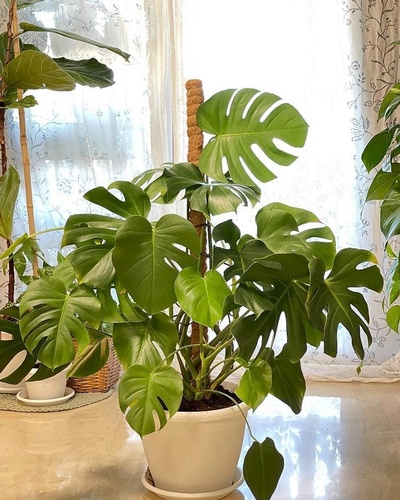Stake Your Vines: Why Supporting Your Plants Help Them Grow

Image by @mondaysofmonstera
Why poles?
Many of our favourite houseplants are actually vines. They look great trailing but will really flourish if allowed to climb. Many of them develop larger leaves and get classic fenestrations as they mature. Which plants benefit? Monsteras, Pothos, Rhaphidophoras, Philodendrons, Hoyas, Syngoniums. In nature they would climb trees. Adding a pole gives your plant the support structure to climb and mature. It can also rein in your plant's sprawling wingspan, allowing you to direct its growth upwards in a column.
There are a great many options available and each come with their own pros and cons.

Image by @your_plantdaddy
Bamboo stakes:
These are available in different lengths and thicknesses. Some are bent into hoops. Typically they are inexpensive and great for plants that need support but don't send out aerial roots to attach to the pole. Great for smaller plants that don't get a lot of weight to them, such as younger plants or hoyas. Gently secure the vine onto it with some string, twine, florist wire, or velcro plant tape. After a few years you may notice that the part under the soil has started to deteriorate due to moisture. But because the plant does not attach itself onto the bamboo, you can safely remove it and replace the pole if it starts to rot of if the plant outgrows it.

Image by @beleafbekind
Planks of wood:
This is another inexpensive option. Wood planks work best for shingling plants like Monstera dubia or Rhaphidophora cryptantha which naturally secure themselves to flat surfaces. But any climbing plant could be secured onto a wood plank with string or velcro plant tape. Wood planks do not stay wet, so there is no maintenance for them. Choose cedar as it is rot-existent. Just like bamboo poles, the part of the plank below the soil line is consistently exposed to moisture. This may eventually lead to rotting. But it is possible to attach the plant to the outside of the pot to prevent this. It's pretty easy to extend the plank if your plant outgrows it by adding another plank behind it. Wooden planks also give your plant a back side which can go right against your wall, allowing all of the growth to be "front-facing."

Image by @mondaysofmonstera
Coir poles:
Coir is a byproduct of the coconut industry. As such it is a more sustainable option than its closest competitor, sphagnum moss. Unlike sphagnum mosses, coir does not stay wet so there is no maintenance on it. It has a rough texture that roots grow onto. Some coir poles are designed to be extendable by allowing another coir pole to slip inside the top of it when the plant outgrows it.Typically they come in two different styles: They can me made with sheets of coir or made with coir twine coiled around a central pole. They both function in the same way for your plant and so the only difference is aesthetic.

Image by @koigardenfarm
Sphagnum moss poles:
This is the best option if your goal for your plant is fast growth. Moss poles can be bought pre-made or you can easily DIY one to suit your budget and length requirements. The intention is for moss poles to remain consistently moist and this encourages the aerial roots to grow into it which allows for faster growth. Sphagnum moss holds many times its weight in water, but dries out quickly, so it will need to be re-moistened every one to two days. This means that it comes with the highest maintenance of all of the poles. Because the roots grow into the moss, if you need to remove the plant from the pole it can be very difficult. Moss can degrade over time so you will need to refresh it every few years. Sphagnum moss can take years to regrow in the wild and as such is not the most sustainable option.
Pro-tip: put the plant and moss pole in a clear plastic garbage bag for 7 to 10 days. It will act as a mini greenhouse and will send aerial roots into the moss pole to secure itself.

Image by @modest_gardens_
Trellis:
Trellises can be made from wood or metal. These are typically found in garden centres and intended for outdoor use. You can find different shapes and sizes, so you can find one that suits your decor style. Like with bamboo poles, the plant must be tied onto the trellis, which makes it easy to remove it if necessary.

Image by @plantlifeleeds
Other options:
The sky is the limit! Be creative and use what is available. Maybe you have a sculptural piece of driftwood or a tree branch from your backyard. Some people even use 3M hooks as a renter-friendly way to secure their vining plant to a wall.
Tips:
- Always get the longest pole you can because extending it may not be an option. Or choose poles that can be extended.
- Leaves will orient themselves in a few days to find the light. So don't worry if they aren't facing the same direction right after you stake it.
- You can always propagate the growth above the pole. With this option you can start an entirely new plant or plant the cuttings back into the same pot to make the plant fuller.
What to do when your plant outgrows the pole?
With luck your plant will grow quickly up the pole and eventually will grow past the top of it. So what happens then? If possible, extend the pole. Some poles are designed to have an extender pole slip into them. Consider staking your plant. It will grow faster and you'll get some spectacular mature leaves.